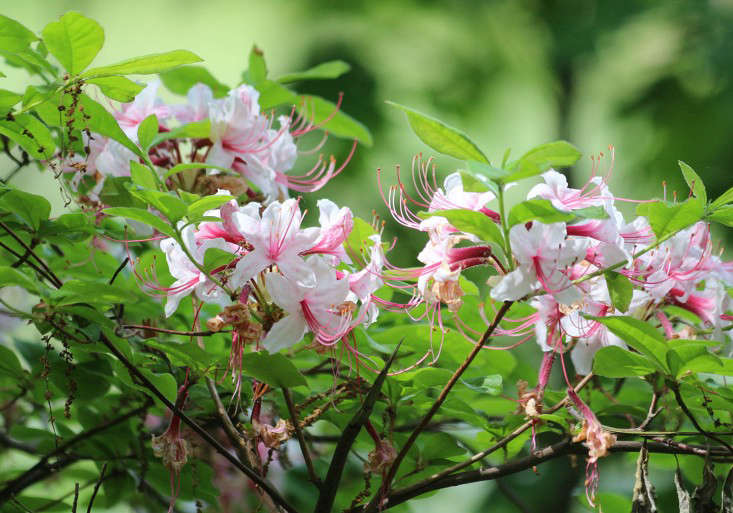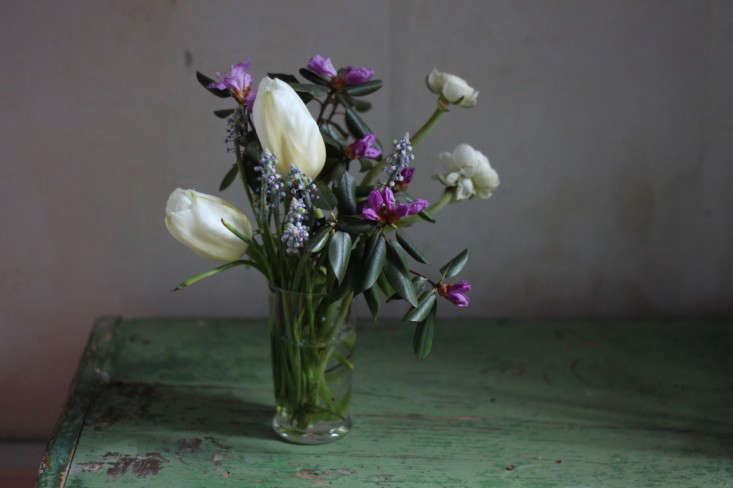Azalea: Little Rhodie
If you were to ask an azalea what her beauty secrets are, like many pretty women, she might just say that her glamour is all genetic. And it would be true. Considered symbols of femininity and womanhood, azaleas have been captivating gardeners with their beauty for centuries—and they don’t need fastidious primping or any special potions to maintain their elegance. They just naturally look good.
Perennial ornament shrubs, azaleas are the most diminutive members of the rhododendron genus:
Above: Photograph by Marie Viljoen. Native pinxter azaleas (Rhododendron canescens) are in bloom. For more, see Secrets in Plain Sight: NYC’s Pelham Bay Park in Spring.
Native to parts of Asia, Europe, and North America, azaleas belong to a plant family that’s more than 70 million years old, and most of those we see today are thought to be descendants of some grown by Buddhist monks ages ago. Very long lived, azaleas can thrive for 100 years or more when given the right conditions and care.
Above: Photograph by Marion Brenner. Satsuki azaleas edge a gravel path that leads to an art gallery shaded by a pergola. For more, see A Texas Garden Where Endangered Plants Flourish.
Above: Photograph by Justine Hand. A single branch of purple azalea adds structure to a vase arrangement of white tulips. For more, see DIY: How to Make a Vase of Flowers Last a Week.
Cheat Sheet
- There are thousands of varieties of azaleas, falling into two main categories—evergreen and deciduous—that can thrive in a wide range of climates.
- Some are fragrant; all azaleas are toxic if eaten.
- Azaleas pair well with ferns, other rhododendrons, camellias, pieris, viburnum, and hellebores.
Keep It Alive
- Azaleas like filtered sun, and well-draining, moist (but never soggy) soil that’s slightly acidic.
- If you need to prune, pinch back evergreen azaleas after they flower and through mid-summer, and prune deciduous types while they’re dormant.
- Azaleas’ height varies widely, from 2 to 15 feet.
Above: Azaleas are planted along the edge of a “river” of rock in a landscape by designer Marc P. Keane. For more, see Designer Visit: A Gray and Green Garden at Tiger Glen. Photograph by Don Freeman.
If your soil is heavy, you can still grow azaleas—just mix as much as 50 percent of organic material (like pine bark or well-rotted compost) into the soil, and plant so that the azalea’s rootball is slightly above the soil level. Some experts don’t fertilize at all; if you choose to, be sure to feed in early spring well before bloom time.
Above: Photograph by Erin Boyle. A topiary azalea with white flowers (at back) is a happy houseplant. For more, see 5 Houseplants That Changed History.
N.B.: So many shrubs, so little time. If you’re designing the back of a border, see our Garden Design 101 guides:
- Begin with Shrubs: A Field Guide
- If you’re looking for shrubs that add color, consider Lilac 101 and Hydrangea 101.
Finally, get more ideas on how to successfully plant, grow, and care for azalea with our Azalea: A Field Guide.
Finally, get more ideas on how to plant, grow, and care for various shrubs and hedges with our Shrubs: A Field Guide.

















Have a Question or Comment About This Post?
Join the conversation (0)